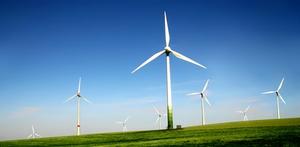EnergyWind power’s contribution has been overestimated
People have often thought that there is no upper bound for wind power — that it is one of the most scalable power sources. After all, gusts and breezes do not seem likely to “run out” on a global scale in the way oil wells might run dry. Yet the latest research in mesoscale atmospheric modeling suggests that the generating capacity of large-scale wind farms has been overestimated.
Harvard research suggests real-world generating capacity of wind farms at large scales has been overestimated
“People have often thought there’s no upper bound for wind power — that it’s one of the most scalable power sources,” says Harvard applied physicist David Keith. After all, gusts and breezes do not seem likely to “run out” on a global scale in the way oil wells might run dry.
Yet the latest research in mesoscale atmospheric modeling, published in the journal Environmental Research Letters, suggests that the generating capacity of large-scale wind farms has been overestimated.
A Harvard university release reports that each wind turbine creates behind it a “wind shadow” in which the air has been slowed down by drag on the turbine’s blades. The ideal wind farm strikes a balance, packing as many turbines onto the land as possible, while also spacing them enough to reduce the impact of these wind shadows. As wind farms grow larger, however, they start to interact, and the regional-scale wind patterns matter more.
Keith’s research has shown that the generating capacity of very large wind power installations (larger than 100 square kilometers) may peak at between 0.5 and 1 watts per square meter. Previous estimates, which ignored the turbines’ slowing effect on the wind, had put that figure at between 2 and 7 watts per square meter.
In short, we may not have access to as much wind power as scientists thought.
An internationally renowned expert on climate science and technology policy, Keith holds appointments as Gordon McKay Professor of Applied Physics at the Harvard School of Engineering and Applied Sciences (SEAS) and as Professor of Public Policy at Harvard Kennedy School. Coauthor Amanda S. Adams was formerly a postdoctoral fellow with Keith and is now assistant professor of geography and Earth sciences at the University of North Carolina at Charlotte.
“One of the inherent challenges of wind energy is that as soon as you start to develop wind farms and harvest the resource, you change the resource, making it difficult to assess what’s really available,” says Adams.
Having a truly accurate estimate matters, of course, in the pursuit of carbon-neutral energy sources. Solar, wind, and hydro power, for example, could all play roles in fulfilling energy needs that are currently met by coal or oil.
“If wind power’s going to make a contribution to global energy requirements that’s serious, 10 or 20 percent or more, then it

